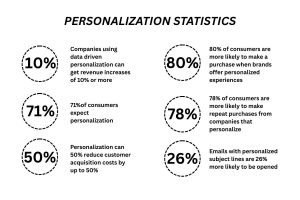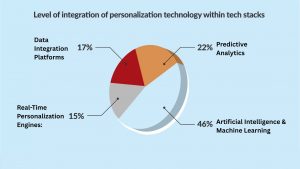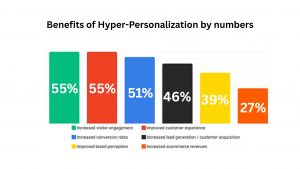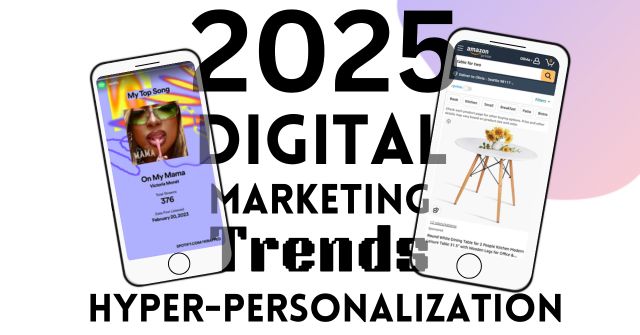Imagine opening your favorite shopping app and being welcomed not by generic deals, but by a curated list of items based on your style, recent searches, and even your location.
Welcome to the age of hyper-personalization. As we step into 2025, brands are moving beyond traditional segmentation to build one-on-one digital experiences that resonate emotionally and drive measurable results.
Hyper-personalization is not just a trend; it’s the new standard for consumer engagement. In this blog, we’ll explore what’s driving this shift, how it works, and why it matters.
1. The Rise of Hyper-Personalization
Personalization in marketing once meant addressing a customer by name or tailoring a newsletter based on a broad interest. In 2025, it means anticipating individual needs before the customer even realizes them. Fuelled by real-time data and machine learning, hyper-personalization allows brands to deliver the right message, on the right platform, at the perfect moment.
It’s emotional marketing powered by intelligence and it works. In fact, personalization today is more than a trend, it’s a revenue driver. Companies using data-driven personalization can see revenue increases of 10% or more, while customer acquisition costs can be reduced by up to 50%. Consumers now are more likely to make repeat purchases from companies that deliver them, and emails with personalized subjects.
Explore the infographic below for a full snapshot of the stats behind the personalization revolution.

2. Key Technologies Powering Hyper-Personalization in 2025
The backbone of hyper-personalization lies in cutting-edge technologies:
-
Artificial Intelligence & Machine Learning: AI processes vast amounts of customer data to identify patterns, predict behaviors, and optimize engagement moments.
-
Predictive Analytics: Helps brands anticipate customer needs, enabling proactive strategies like restock reminders or churn prevention.
-
Data Integration Platforms: Unified customer data platforms (CDPs) consolidate information across websites, apps, social media, and offline interactions for a comprehensive view.
- Real-Time Personalization Engines: These tools dynamically tailor website content, app interfaces, and email messages as users interact with a brand.
These statistics below highlights how businesses are integrating these four personalization technologies into their existing marketing technology stacks, with AI and predictive analytics leading the way.

3. Personalization Roadmap in 2025
Hyper-personalization doesn’t happen by accident. It follows a structured roadmap that begins with strategic planning, moves through execution, and ends with constant optimization.
- Strategy: Brands must first align their personalization goals with broader business and marketing strategies. This includes preparing their data infrastructure and developing a 360-degree view of the customer.
- Execution: With a solid foundation in place, marketers can begin segmenting audiences, planning tailored campaigns, and executing personalized messaging across multiple channels.
- Optimization & Improvement: The journey doesn’t end at launch. Ongoing testing, performance analytics, and actionable insights ensure campaigns evolve to better meet customer needs.
This roadmap below highlights how strategic thinking, executional excellence, and constant iteration work together to power successful hyper-personalization in 2025.

4. Benefits of Hyper-Personalization
Hyper-personalization offers transformative benefits for both businesses and consumers:
- Increased Visitor Engagement: Personalized content captures attention and encourages deeper interaction.
- Increased Conversion Rates: Tailored messages lead to higher response rates and more successful sales.
- Improved Brand Perception: Customization signals care and innovation, elevating brand image.
- Improved Customer Experience: Personalized journeys make users feel seen and valued.
- Increased Lead Generation / Customer Acquisition: Hyper-targeted campaigns attract more qualified leads.
- Increased Ecommerce Revenues: Suggesting relevant products boosts cart sizes and purchase frequency.
The image below shows the statistics of these benefits to illustrate the measurable impact of hyper-personalization.

5. Real-World Applications
Retail: Amazon’s Hyper-Curated Homepages
Amazon leads with AI-driven product recommendations, personalized discounts, and even dynamic homepage layouts tailored to individual user preferences.
Entertainment: Spotify Wrapped
Spotify’s year-end campaign is a masterclass in hyper-personalization, turning user data into emotional, shareable experiences.
Travel: Airbnb’s Smart Suggestions
Airbnb now uses behavioral data to recommend trips, experiences, and accommodations based on your browsing and booking history.
Finance: Revolut App with Tailored Dashboards
Apps like Revolut adjust financial tips, notifications, and dashboards based on user spending habits and goals.
Too Long to Read?
-
Hyper-personalization in 2025 is about delivering real-time, emotionally resonant experiences tailored to each user’s behavior, location, and preferences.
-
Key technologies include AI, machine learning, predictive analytics, data integration platforms, and real-time personalization engines.
-
AI and predictive analytics lead in adoption among marketers to optimize content, timing, and delivery.
-
A successful hyper-personalization strategy follows a roadmap: align goals, execute campaigns across channels, and continuously optimize.
-
Personalization drives higher engagement, conversions, brand perception, and customer satisfaction.
Please Leave a Comment & Check out other similar blogs:
2025 Digital Marketing Trends: How AI Is Revolutionizing Customer Experience
2025 Digital Marketing Trends: How to Build Customer Journeys
2025 Digital Marketing Trends: Interactive Content – How Gamification and AR Will Dominate




Très bon article Yazid! La personnalisation est clairement la clé pour engager le monde aujourd’hui
Absolument André! La personnalisation est une excellente opportunité pour les marques de créer des relations plus fortes et basées sur la confiance. Par curiosité, selon vous, quelle méthode de personnalisation sera la plus efficace à l’avenir ?
Pour moi, l’IA et les plateformes de données feront la différence. Et toi, quelle tech tu privilégierais ?
Je te rejoins totalement, l’IA et les CDP sont incontournables. Personnellement, je miserais aussi sur les moteurs de personnalisation en temps réel pour adapter les contenus instantanément selon le comportement des utilisateurs.
Excellente remarque Yazid! Les moteurs en temps réel, c’est clairement l’avenir surtout avec l’explosion des interactions omnicanales
Tout à fait d’accord André! Les moteurs en temps réel permettent aux marques de s’adapter instantanément au comportement des utilisateurs, ce qui renforce considérablement la pertinence des messages. Penses-tu que l’IA prédictive jouera un rôle encore plus central dans cette hyper-personnalisation à l’avenir ?
Absolument AI va devenir incontournable. Elle permet non seulement d’anticiper les besoins des clients, mais aussi de personnaliser les parcours de manière proactive.
Entièrement d’accord avec toi André. L’anticipation des besoins grâce à l’IA ouvre la voie à une personnalisation réellement proactive. Le défi sera de trouver le bon équilibre entre automatisation et ressenti humain pour que l’expérience reste authentique.
Airbnb’s approach to hyper-personalization is really impressive! They actually suggested trips and experiences for me based on my previous searches and bookings. It felt like they truly understood what I was looking for. Yazid I really like the brands examples you put in.
I agree with u Llorian, Airbnb is a great example of how hyper-personalization can enhance the user experience, it feels less like marketing and more like thoughtful service. Do you think more travel companies will follow Airbnb’s lead with this level of personalization?
Definitely, I think hyper-personalization is going to become the standard rather than the exception, especially in the travel industry where experiences matter so much.
Absolutely, In such a competitive industry, offering tailored experiences can really set a brand apart
Excellent topic, the explanation of hyper-personalization is spot on, and the examples show how brands can truly connect with customers on a deeper level. Keep it up!
Thank you for your comment! I’m really glad the explanation and examples resonated with you, hyper-personalization is definitely becoming a game-changer in how brands build meaningful customer relationships. Which brand do you think is currently doing a great job with hyper-personalization?
I’d say Amazon bexause it’s still leading the pack when it comes to hyper personalization, the way they tailor product recommendations and content based on browsing and purchase history is impressive.
Great pick Steve, Amazon really sets the bar high with how seamlessly they integrate data into the user experience it feels effortless but incredibly effective